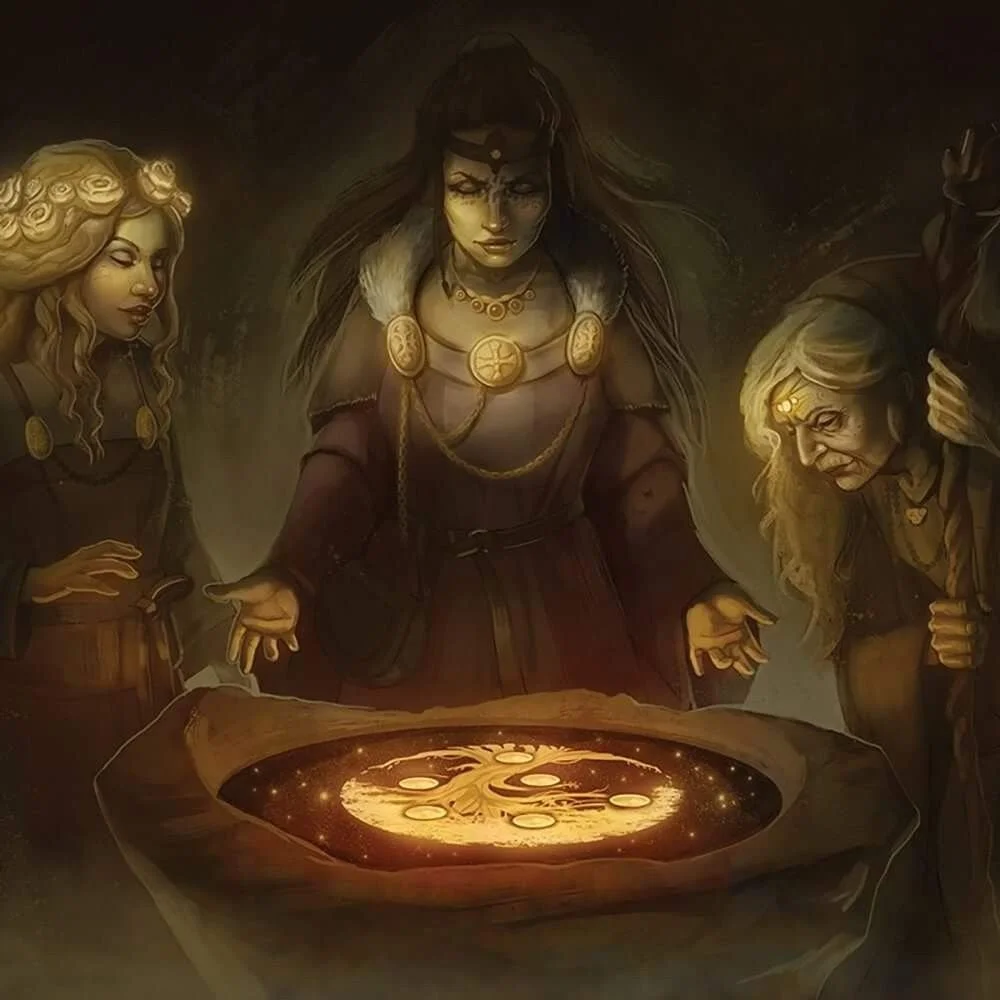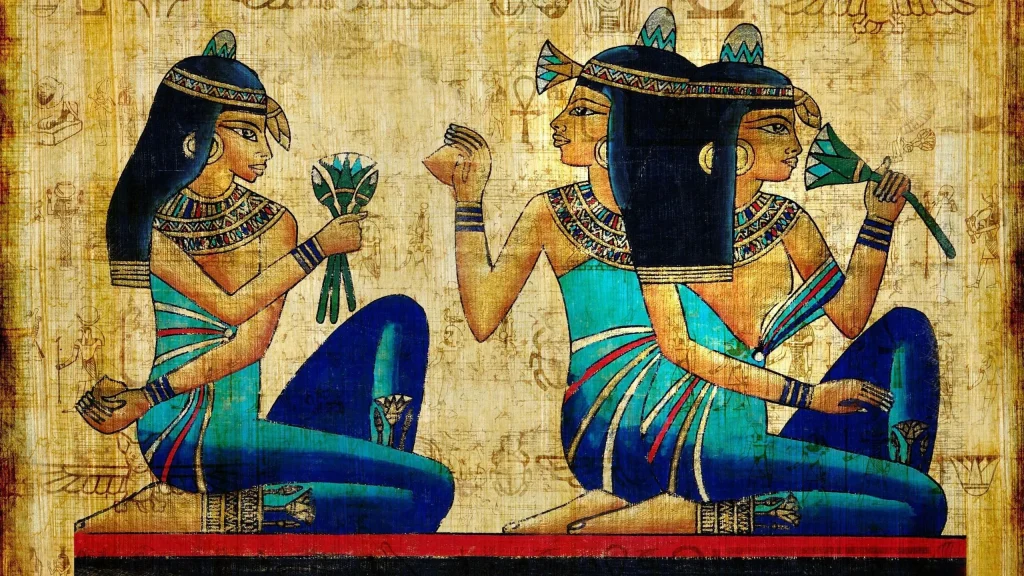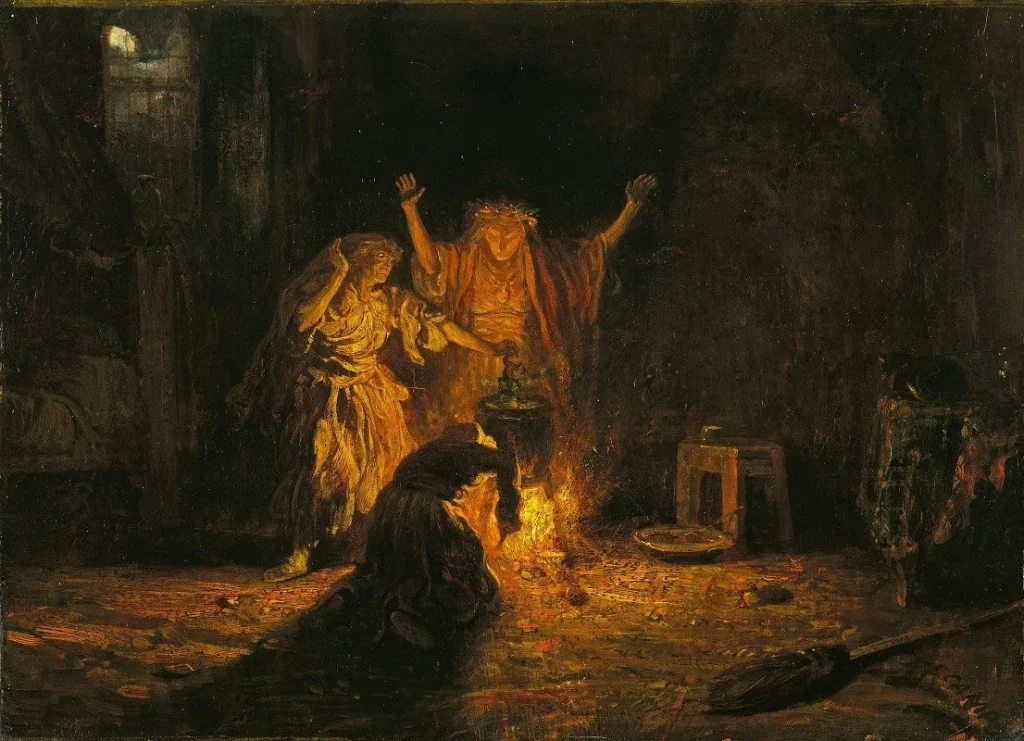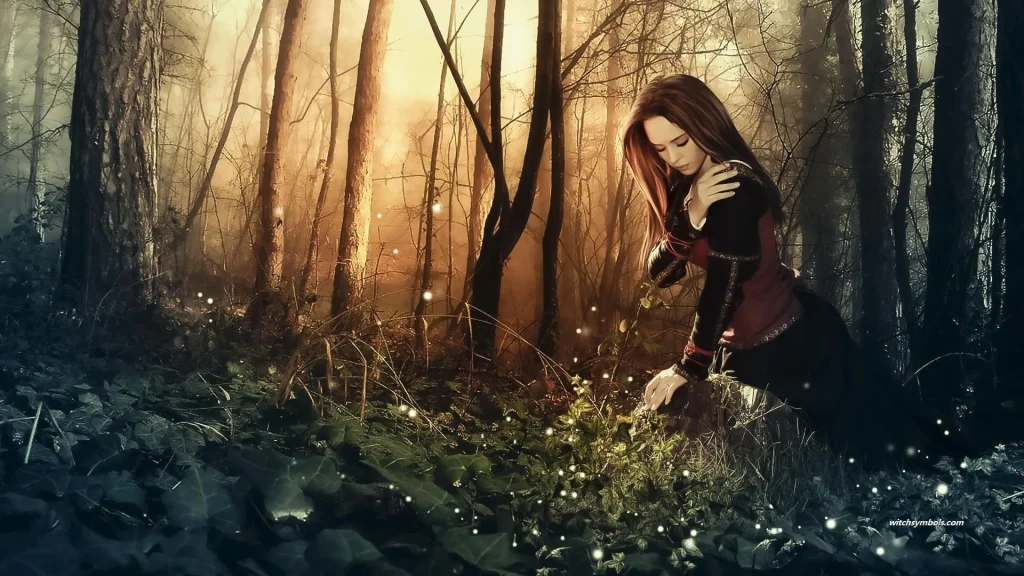The concept of witches has a long and complex history that spans across various cultures and time periods. Witches in ancient times were often associated with the practice of witchcraft, which involved the use of supernatural powers or the invocation of spirits for various purposes, both for good and evil, like dark magic.
How did witches start?
Witches, as mystical beings believed to possess supernatural powers, have captivated human imagination for centuries. The origins of witches can be traced back to ancient cultures across different civilizations. The concept of witches likely emerged from an amalgamation of folklore, superstitions, and religious practices prevalent in these societies.
In ancient times, witches were often associated with pagan belief systems that revered nature and its forces. They were believed to commune with spirits, use herbs and potions for healing and even powerful witch symbols, and perform divination rituals. In some cultures, witches were revered as wise women who held immense knowledge of herbal medicine and were sought after for their healing abilities. However, as time passed and religious ideologies shifted, the perception of witches underwent a drastic transformation, leading to their demonization and persecution in later centuries. This evolution of viewpoints contributed to the prevalent image of witches as malevolent figures associated with dark magic and harm-doing.


Who is the first witch?
The concept of the first witch is deeply rooted in mythology and folklore, making it difficult to pinpoint a specific individual. In various ancient cultures, the idea of a witch-like figure existed, often associated with women who possessed supernatural powers. However, it is essential to note that these early depictions of witches were diverse and varied across different regions and time periods.
One of the earliest recorded references to a witch-like figure can be found in ancient Mesopotamian texts, which date back to around 2000 BCE. These texts mention a female sorceress known as an “asipu,” who was believed to possess the ability to communicate with gods and to use magic for both healing and harmful purposes. These early witches, though not exactly like the witches we imagine today, laid the foundation for the development of witchcraft beliefs and practices throughout history.
Here are some key points about witches in ancient history:
Ancient Mesopotamia:
In ancient Mesopotamia, which is considered one of the cradles of civilization, there were references to magical practices and individuals who were considered practitioners of witchcraft. The Akkadian term “mašmašu” was used to describe witches or sorcerers.
Ancient Egypt:
In ancient Egypt, there were references to magic and sorcery, and some individuals were accused of using magical spells for harmful purposes. The “Book of the Dead” contains spells and incantations that were believed to protect the deceased from malevolent forces.
Middle Ages and the Witch Hunts:
The image of witches as malevolent beings with supernatural powers became more prominent in the late Middle Ages and the early modern period. The European witch hunts, which peaked in the 16th and 17th centuries, resulted in the persecution and execution of many individuals, primarily women, who were accused of being witches. These witch hunts were driven by religious, social, and political factors.
Folklore and Mythology:
Witches also feature prominently in folklore and mythology across the world. They are often depicted as wise women with knowledge of herbal medicine and healing, but they can also be portrayed as malevolent figures who bring harm and misfortune.
Contemporary Witchcraft:
In modern times, witchcraft has seen a resurgence, particularly in the form of Wicca and other neopagan and New Age movements. These modern practitioners often focus on nature-based spirituality and magic, and they may identify as witches.
As civilization progressed, similar concepts of witches emerged in ancient Egypt, Greece, and Rome, each with their unique characteristics and roles. The ancient Egyptians, for instance, believed in the existence of women with supernatural powers called “sa,” who were associated with healing and protection. Meanwhile, the ancient Greeks recognized witches known as “pharmakides,” who were believed to possess magical potions and spells. Similarly, the Romans had their own term for witches, referring to them as “strix” or “lamiae.” These early references shed light on the evolution of the witch archetype and the diverse cultural interpretations of witchcraft during ancient times.
Ancient Greece and Rome:
In ancient Greece and Rome, various forms of magic and witchcraft were practiced. Witches were often associated with female practitioners of magic, and some of them were believed to have the ability to cast spells and curses.


Who are the nine old witches?
To this day, the origin of the first witch remains shrouded in mystery, primarily due to the vast array of mythological and historical accounts. Nevertheless, examining these ancient cultures and their depictions of witch-like figures offers valuable insights into the historical development and significance of witches in society. Understanding the journey of witches from their early beginnings in ancient times to the present day allows us to appreciate their enduring and influential role in human culture and imagination.
The nine old witches are legendary figures that have been a subject of fascination and speculation for centuries. These powerful sorceresses are said to possess ancient and immense magical abilities, making them revered and feared amongst both humans and supernatural beings alike.
Their names, shrouded in mystery and myth, have been handed down through generations, whispered in hushed tones by those who study the world of witchcraft. Many believe that these nine witches represent the embodiment of various elements and energies, each holding dominion over a specific realm of the supernatural. Some of the keywords associated with these renowned witches include power, history, magic, legends, and secrets. Exploring the identities and stories of the nine old witches allows us to delve into the rich tapestry of supernatural lore and gain a deeper understanding of the mystical world that lies beyond our own.
Here are a Ancient witches names:
- Morgan le Fay: A powerful sorceress from Arthurian legend.
- Circe: A witch from Greek mythology who is known for her transformation spells in Homer’s “The Odyssey.”
- The Wicked Witch of the West: A character from L. Frank Baum’s “The Wizard of Oz.”
- The White Witch (Jadis): A character from C.S. Lewis’s “The Chronicles of Narnia” series.
- Baba Yaga: A supernatural being in Slavic folklore, often portrayed as a witch.
- Maleficent: A fictional Disney character and antagonist in “Sleeping Beauty.”
- Endora: Samantha’s mother in the TV series “Bewitched.”
- Bellatrix Lestrange: A dark witch in J.K. Rowling’s “Harry Potter” series.
- Elphaba: The Wicked Witch of the West in Gregory Maguire’s “Wicked” and the musical adaptation.
These are just a few examples, and there are many more witches in literature, mythology, and pop culture, each with their unique characteristics and stories.
What were the original witches?
The original witches, found in various ancient traditions, held a significant position in the spiritual beliefs and practices of their respective societies. Their existence can be traced back to civilizations such as the Sumerians, Egyptians, and Greeks. These early witches were revered for their connection to nature and their ability to harness the energies of the earth.
In ancient Sumer, the original witches, known as kash-shaptu, were highly regarded priestesses who possessed extensive knowledge of magic and herbal healing. They played a vital role in religious ceremonies and were believed to communicate with the gods. Similarly, in ancient Egypt, the original witches, referred to as shai or hemet, were revered as powerful seers and healers. They were deeply connected to the divine and utilized their magical abilities to restore balance and harmony in their communities.
This exploration of the original witches unravels the deep-rooted connections between ancient civilizations and the practice of witchcraft. As we delve further into history, the significance and influence of these original witches become all the more apparent. Understanding the roots of witchcraft can shed light on the rich tapestry of beliefs and rituals that shape our modern understanding of the craft.
What were witches in ancient culture?
In ancient cultures, witches held a significant place in society and were often regarded as powerful and mystical beings. They were believed to possess the ability to connect with the supernatural realm, and their practices involved harnessing and manipulating energies for various purposes. Across different civilizations and time periods, witches were associated with different roles and responsibilities.
In some ancient cultures, witches were seen as healers and wise women who possessed the knowledge of medicinal herbs and remedies. They were sought after to provide cures for ailments and offer advice on various aspects of life. These witches were respected and revered for their abilities to bring comfort and restore harmony within communities. However, not all ancient cultures held witches in high regard. In some societies, witches were viewed with suspicion and fear, often being accused of using their powers for malicious purposes. They were considered to be in alliance with dark forces and were blamed for misfortunes, such as crop failures or sicknesses. As a result, witch trials and persecutions were common phenomena in many ancient cultures.
What is the oldest witchcraft tradition?
The oldest witchcraft tradition dates back centuries, rooted in the ancient civilization of Mesopotamia. Known as the “Art of Enchantments,” this early practice involved harnessing the powers of various deities and spirits to manipulate the natural world. Shamans, often women, played a central role in this tradition, performing rituals to communicate with the spirit realm and seek guidance in their daily lives. These ancient witches were highly revered for their ability to heal, protect, and bring about positive change.
Over time, the practice of witchcraft spread to other cultures, with each society adding its own unique elements. In ancient Egypt, for example, witches were seen as intermediaries between the divine and mortal realms. They utilized rituals, divination, and herbalism to assist their communities. Similarly, in ancient Greece and Rome, witchcraft involved invoking specific gods and goddesses to invoke their powers for various purposes. From the fertile lands of Mesopotamia to the grand realms of ancient Egypt and Greece, the oldest witchcraft tradition laid the groundwork for the diverse beliefs and practices we see today.


What were Roman witches called?
Roman witches were commonly known as “stregas.” Derived from the Latin word “strixa,” meaning sorceress, the term referred to women who practiced witchcraft in ancient Rome. These stregas were believed to possess supernatural powers and could manipulate the forces of nature to their advantage. While their practices were often associated with dark magic and malevolent intent, not all stregas were seen as evil. Some were seen as healers and wise women, using their knowledge of herbs and rituals to help those in need.
The role of the strega in Roman society was complex and often intertwined with religious beliefs. They were believed to communicate with the spirits through divination and were often associated with the goddess Diana, who was revered as the patroness of witches. Despite being feared and even persecuted by some, stregas held a significant position in ancient Roman culture. They were consulted for their magical abilities and were thought to possess the power to influence the outcome of events.
How can you spot a witch?
One of the most intriguing questions in folklore is how to spot a witch. While there is no foolproof method, certain characteristics and behaviors have been traditionally associated with witches throughout history. One common trait often linked to witches is their choice of attire. Witches were believed to wear dark clothes, particularly black, which was thought to represent their connection to the darkness and unknown. Additionally, they were said to frequently don veils or cloaks to hide their true identities, further adding to their air of mysteriousness. These distinctive clothing choices served as a visual cue that sent a clear message: beware, for a witch may be in your midst.
Apart from their choice of clothing, witches were also thought to possess certain physical traits that set them apart from others. It was widely believed that witches had long, unkempt hair that was tangled and wild. This disheveled appearance was seen as a reflection of their spiritual connection to the untamed forces of nature. Furthermore, witches were often depicted with a menacing gaze, commonly associated with their alleged ability to enchant or cast spells on unsuspecting victims. This piercing gaze, combined with their disheveled hair and peculiar attire, was believed to be a clear indicator of their otherworldly powers.
Final Thoughts
These ancient witches names, like Circe and Hecate, provide a glimpse into the rich tapestry of witchcraft throughout history. Each name represents a different aspect of the craft, with its own unique power and symbolism. As we delve deeper into the ancient world of witches, we discover more names that captivate our imagination and allow us to connect with the enchanting world of the past.
The lore surrounding ancient witches is filled with fascinating stories and mysterious names. These names often hold deep significance, carrying with them the power and wisdom that these witches possessed. One such name that echoes through the ages is Circe, a Greek witch known for her ability to transform humans into animals. Circe’s name conjures images of enchantment and spells, embodying the essence of ancient witchcraft.


Pingback: Ancient Witches: Conjuring the Past From Babylo...